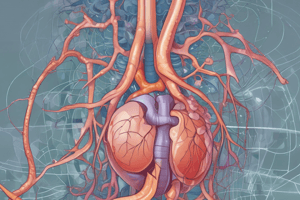Podcast
Questions and Answers
What is a primary therapeutic indication for potassium-sparing diuretics like Spironolactone and Eplerenone?
What is a primary therapeutic indication for potassium-sparing diuretics like Spironolactone and Eplerenone?
- Prevention of kidney stones
- Treatment of sodium retention
- Increased hydrogen ion excretion
- Management of conditions with aldosterone excess (correct)
Which diuretic is most specifically associated with the risk of gynecomastia?
Which diuretic is most specifically associated with the risk of gynecomastia?
- Furosemide
- Amiloride
- Spironolactone (correct)
- Eplerenone
What is a significant adverse effect of osmotic diuretics like Mannitol?
What is a significant adverse effect of osmotic diuretics like Mannitol?
- ECF volume expansion (correct)
- Metabolic alkalosis
- Hyperkalemia
- Hypokalemia
What do thiazide diuretics primarily do in relation to sodium and water excretion?
What do thiazide diuretics primarily do in relation to sodium and water excretion?
Which of the following drugs is a loop diuretic?
Which of the following drugs is a loop diuretic?
What is a common metabolic consequence of potassium-sparing diuretics?
What is a common metabolic consequence of potassium-sparing diuretics?
In the management of acute renal failure, osmotic diuretics serve primarily to:
In the management of acute renal failure, osmotic diuretics serve primarily to:
Which adverse effect is particularly concerning in patients taking potassium-sparing diuretics and also on renin-angiotensin system inhibitors?
Which adverse effect is particularly concerning in patients taking potassium-sparing diuretics and also on renin-angiotensin system inhibitors?
What is the primary mechanism of action of loop diuretics in the nephron?
What is the primary mechanism of action of loop diuretics in the nephron?
Which of the following is NOT an indication for the use of carbonic anhydrase inhibitors?
Which of the following is NOT an indication for the use of carbonic anhydrase inhibitors?
Which adverse effect is most commonly associated with the use of loop diuretics?
Which adverse effect is most commonly associated with the use of loop diuretics?
What is a unique characteristic of potassium-sparing diuretics compared to other diuretics?
What is a unique characteristic of potassium-sparing diuretics compared to other diuretics?
Which loop diuretic is recognised as the prototype with the most potent effects?
Which loop diuretic is recognised as the prototype with the most potent effects?
Which diuretic class can lead to metabolic acidosis due to its mechanism of action?
Which diuretic class can lead to metabolic acidosis due to its mechanism of action?
What potential interaction should be monitored when a patient is on loop diuretics?
What potential interaction should be monitored when a patient is on loop diuretics?
What is a common adverse effect associated with thiazide diuretics?
What is a common adverse effect associated with thiazide diuretics?
What is the primary adverse effect associated with carbonic anhydrase inhibitors?
What is the primary adverse effect associated with carbonic anhydrase inhibitors?
Which diuretic class is characterized by causing significant sodium and water excretion, affecting both urine output and blood pressure?
Which diuretic class is characterized by causing significant sodium and water excretion, affecting both urine output and blood pressure?
What is a primary characteristic of loop diuretics in the management of acute pulmonary edema?
What is a primary characteristic of loop diuretics in the management of acute pulmonary edema?
Which class of diuretics is most likely to cause significant hypokalemia leading to digoxin toxicity?
Which class of diuretics is most likely to cause significant hypokalemia leading to digoxin toxicity?
What common adverse effect is associated with thiazide diuretics?
What common adverse effect is associated with thiazide diuretics?
Which diuretic class is unnecessary for patients with severely reduced renal function?
Which diuretic class is unnecessary for patients with severely reduced renal function?
What effect does thiazide diuretics have on calcium levels in the body?
What effect does thiazide diuretics have on calcium levels in the body?
Which adverse effect is specifically associated with the use of ethacrynic acid?
Which adverse effect is specifically associated with the use of ethacrynic acid?
What is the primary mechanism of action for potassium-sparing diuretics?
What is the primary mechanism of action for potassium-sparing diuretics?
Which of the following interactions can diminish the effectiveness of thiazide diuretics?
Which of the following interactions can diminish the effectiveness of thiazide diuretics?
In which scenario would the addition of thiazide diuretics be beneficial?
In which scenario would the addition of thiazide diuretics be beneficial?
Which condition can hyperuricemia from diuretic use potentially trigger?
Which condition can hyperuricemia from diuretic use potentially trigger?
What serious adverse effect can occur due to chronic diuretic use?
What serious adverse effect can occur due to chronic diuretic use?
Which diuretic is suggested as the primary choice for patients with nephrotic syndrome?
Which diuretic is suggested as the primary choice for patients with nephrotic syndrome?
What effect do thiazide diuretics have on lipid profiles?
What effect do thiazide diuretics have on lipid profiles?
Flashcards are hidden until you start studying
Study Notes
Diuretics
- Diuretics inhibit the reabsorption of solute in the nephron, which leads to water remaining in the tubule and being excreted.
- Most diuretics act by inhibiting the reabsorption of sodium, potassium, and chloride, but vary in their site of action along the nephron.
Carbonic Anhydrase Inhibitors
- Carbonic anhydrase inhibitors primarily act in the proximal convoluted tubule (PCT) and block the carbonic anhydrase enzyme.
- These inhibitors prevent the reabsorption of bicarbonate and sodium, leading to a rise in the concentration of these ions in the tubular fluid.
- Bicarbonate loss leads to metabolic acidosis.
- These are not very potent diuretics and their effects wane after several days.
- They have a wide range of uses, including treatment of glaucoma, altitude sickness, and seizures.
Loop Diuretics
- Loop diuretics are the most potent diuretics and act in the ascending limb of the loop of Henle, where they inhibit the Na+/K+/2Cl- cotransporter.
- They can cause an increase in urine output of up to 20% of the filtered load.
- They also inhibit reabsorption of calcium and magnesium, resulting in their increased excretion in the urine.
- Often used to treat edema associated with heart failure, hypertension, and nephrotic syndrome.
Thiazides
- These diuretics act in the distal convoluted tubule (DCT) where they inhibit the sodium chloride exchanger.
- They are widely used to treat hypertension and edema.
- They often augment their effects on blood pressure through the inhibition of peripheral vascular resistance.
- Often used for their antihypertensive action as they can decrease systemic vascular resistance.
Thiazide-Like Diuretics
- These drugs are similar to thiazides in their mechanism of action but may be used in situations where thiazide diuretics may not be effective, such as impaired renal function.
- The most common example is metolazone.
Potassium-Sparing Diuretics
- These diuretics act in the distal nephron and have a unique mechanism of action compared to other diuretics, which is to antagonize the effects of aldosterone.
- Two classes : 1. Aldosterone receptor antagonists (e.g., spironolactone) 2. Sodium channel blockers (e.g., amiloride, triamterene).
- They reduce sodium reabsorption and increase potassium reabsorption.
- They are often used to offset the potassium loss caused by other diuretics.
Osmotic Diuretics
- These diuretics are nonabsorbable and act in all water-permeable segments of the nephron, including the PCT and descending limb of the loop of Henle.
- They are hypertonic solutions that must be given intravenously.
- Their primary use is to reduce intracranial pressure, or prevent acute renal failure due to nephrotoxic agents.
ADH Antagonists
- These drugs selectively inhibit the action of ADH, leading to increased water excretion without affecting sodium excretion.
- They can be used in cases of hyponatremia to increase plasma sodium levels.
Studying That Suits You
Use AI to generate personalized quizzes and flashcards to suit your learning preferences.




